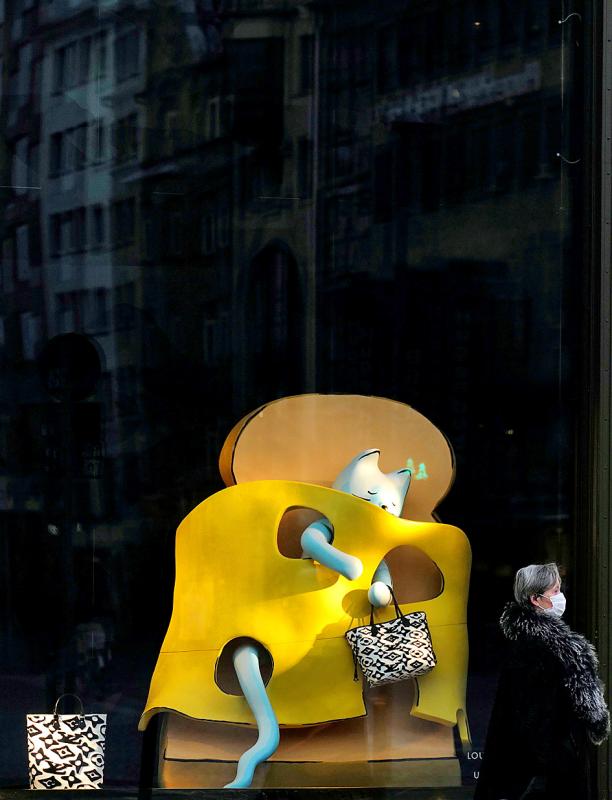LVMH weathered a new round of COVID-19 lockdowns thanks to the resilient appeal of its Louis Vuitton bags.
Sales of fashion and leather goods soared 18 percent on an organic basis in the fourth quarter, the luxury conglomerate said on Tuesday. Analysts had expected growth of 11 percent.
Demand from Chinese consumers, who have been spending at home with travel abroad virtually impossible, has helped LVMH withstand the effects of the pandemic.

Photo: Reuters
Revenue in Asia and Japan rose 21 percent and 5 percent respectively in the period, while Europe lagged behind with a drop of almost a quarter.
Overall, organic revenue at LVMH fell 3 percent to 14.3 billion euros (US$17.3 billion) in the fourth quarter, an improvement from the past three quarters, signaling that the dominant luxury conglomerate is on a steady recovery.
Full-year profit from recurring operations was 8.3 billion euros. Analysts expected 7.2 billion euros.
At Louis Vuitton — the company’s cash cow — LVMH was able to put cost controls in place that limited profit’s decline to 2 percent. Performance was also helped by price increases.
“After several years of flat prices, I think 2020 was the year to do that,” LVMH chief financial officer Jean-Jacques Guiony said during an analyst call.
Meanwhile, Christian Dior gained market share last year and the label benefited from the successful launch of the Bobby handbag.
While there are “risks” regarding the COVID-19 situation in China, the country “has proven quite in control over the last few quarters,” Guiony said. “It’s not the place where I would assign the largest lockdown risks.”
LVMH did not disclose the share of its online sales last year, as that rate is not sustainable if the pandemic gets under control and shoppers return to physical stores, Guiony added. That share was 9 percent in 2019.
He also said there was no reason to believe tourism — in Europe notably — would disappear forever.
“We see no particular reason why we should be shutting down stores particularly in Europe,” Guiony said. “We think we can recover the lost business with tourists coming back and developing the local client base.”
LVMH’s selective retail unit, which includes Sephora and DFS, was the hardest hit last year amid a halt in international travel. That unit swung to a loss of 203 million euros for the year.
Guiony said that returning that business to its pre-pandemic levels would take time.
The biggest luxury conglomerate has become even larger recently. Earlier this month, LVMH completed a deal to buy Tiffany & Co.
The company plans to take about three months to dive into Tiffany’s business model and get a clearer picture of the problems it is facing, Guiony said.
The conglomerate is seeking to improve its margin, he said, without giving specific targets.

The US dollar was trading at NT$29.7 at 10am today on the Taipei Foreign Exchange, as the New Taiwan dollar gained NT$1.364 from the previous close last week. The NT dollar continued to rise today, after surging 3.07 percent on Friday. After opening at NT$30.91, the NT dollar gained more than NT$1 in just 15 minutes, briefly passing the NT$30 mark. Before the US Department of the Treasury's semi-annual currency report came out, expectations that the NT dollar would keep rising were already building. The NT dollar on Friday closed at NT$31.064, up by NT$0.953 — a 3.07 percent single-day gain. Today,

‘SHORT TERM’: The local currency would likely remain strong in the near term, driven by anticipated US trade pressure, capital inflows and expectations of a US Fed rate cut The US dollar is expected to fall below NT$30 in the near term, as traders anticipate increased pressure from Washington for Taiwan to allow the New Taiwan dollar to appreciate, Cathay United Bank (國泰世華銀行) chief economist Lin Chi-chao (林啟超) said. Following a sharp drop in the greenback against the NT dollar on Friday, Lin told the Central News Agency that the local currency is likely to remain strong in the short term, driven in part by market psychology surrounding anticipated US policy pressure. On Friday, the US dollar fell NT$0.953, or 3.07 percent, closing at NT$31.064 — its lowest level since Jan.

Hong Kong authorities ramped up sales of the local dollar as the greenback’s slide threatened the foreign-exchange peg. The Hong Kong Monetary Authority (HKMA) sold a record HK$60.5 billion (US$7.8 billion) of the city’s currency, according to an alert sent on its Bloomberg page yesterday in Asia, after it tested the upper end of its trading band. That added to the HK$56.1 billion of sales versus the greenback since Friday. The rapid intervention signals efforts from the city’s authorities to limit the local currency’s moves within its HK$7.75 to HK$7.85 per US dollar trading band. Heavy sales of the local dollar by

The Financial Supervisory Commission (FSC) yesterday met with some of the nation’s largest insurance companies as a skyrocketing New Taiwan dollar piles pressure on their hundreds of billions of dollars in US bond investments. The commission has asked some life insurance firms, among the biggest Asian holders of US debt, to discuss how the rapidly strengthening NT dollar has impacted their operations, people familiar with the matter said. The meeting took place as the NT dollar jumped as much as 5 percent yesterday, its biggest intraday gain in more than three decades. The local currency surged as exporters rushed to